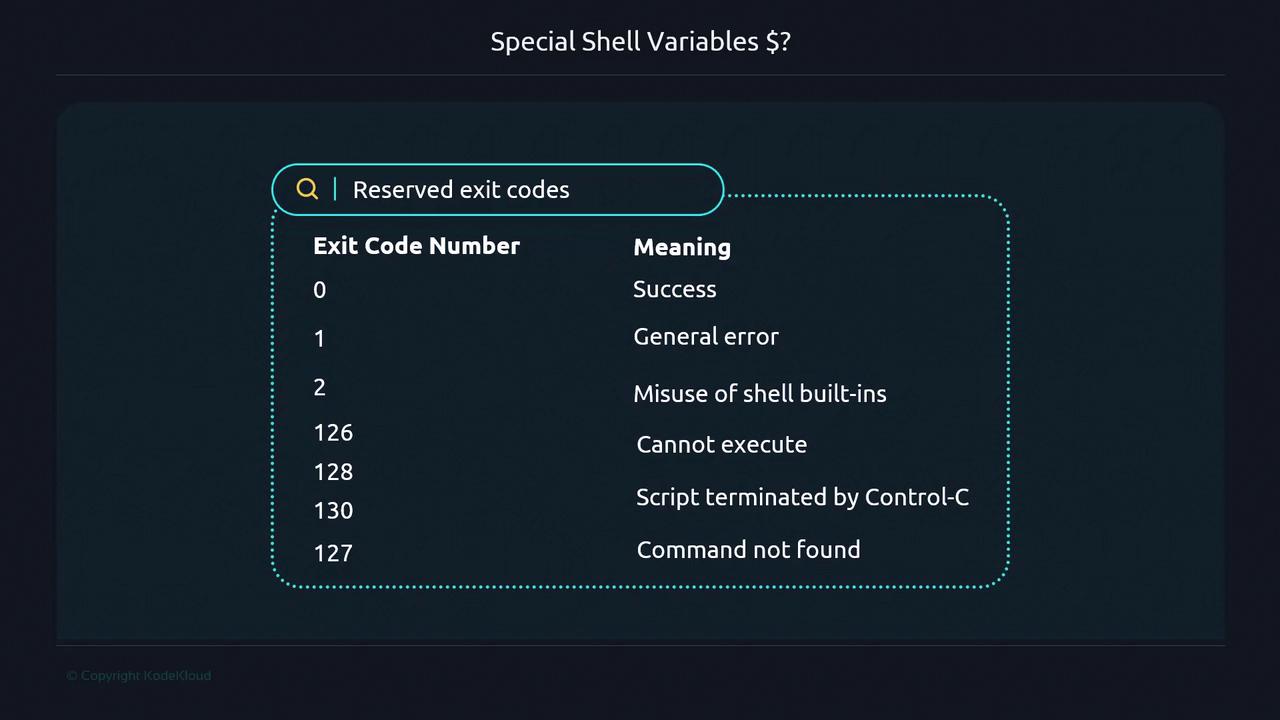Advanced Bash Scripting
Special Shell Variables
Special shell Question mark
In Bash and other POSIX-compliant shells, the special variable $? holds the exit status of the last executed command, script, or function. Checking this value is essential for robust error handling in shell scripts.
Table of Contents
Part 1: Using $?
What Is an Exit Status?
Every command returns an integer exit status.
- 0 means success.
- Non-zero indicates failure or a specific error condition.

Note
If you redirect both stdout and stderr (e.g., > /dev/null 2>&1), you won’t see any output, but $? still reflects success or failure.
Inspecting $? in Practice
Script with a typo:
#!/usr/bin/env bash ehco "Hello!"$ ./wrong_echo.sh > /dev/null 2>&1 $ echo $? 127Exit code 127 means “command not found.”
Successful command:
$ ls music videos photos documents $ echo $? 0File-not-found error:
$ ls some_file.txt ls: cannot access 'some_file.txt': No such file or directory $ echo $? 2
Common Exit Codes

| Exit Code | Meaning |
|---|---|
| 0 | Success |
| 1 | General error |
| 2 | Misuse of shell built-ins |
| 126 | Command found but not executable |
| 127 | Command not found |
| 130 | Script terminated by Ctrl-C |
Note
You can define custom exit codes (128 and above) to represent specific failure modes in your scripts.
Back-to-Back Commands
When you execute multiple commands, $? always reflects the last exit status:
$ ./script.sh
permission denied: ./script.sh
$ echo $?
126
$ ls script.sh
script.sh
$ echo $?
0
Masking Errors
A trailing exit 0 can hide earlier failures:
#!/usr/bin/env bash
ehco "Hello!"
exit 0
$ ./wrong_echo.sh
./wrong_echo.sh: line 2: ehco: command not found
$ echo $?
0
Part 2: Writing Scripts That Leverage $?
To ensure your script stops on errors and reports accurate statuses, apply one of these techniques.
Technique 1: if After Each Command
#!/usr/bin/env bash
ehco "Hello!"
if [[ $? -ne 0 ]]; then
echo "Error: Failed to run command."
exit 1
fi
echo "Command ran successfully!"
exit 0
$ ./wrong_echo-v2.sh
./wrong_echo-v2.sh: line 2: ehco: command not found
Error: Failed to run command.
$ echo $?
1
Technique 2: OR Operator (||)
#!/usr/bin/env bash
ehco "Hello!" || { echo "Error: Failed to run command."; exit 1; }
exit 0
$ ./wrong_echo-v3.sh
./wrong_echo-v3.sh: line 1: ehco: command not found
Error: Failed to run command.
$ echo $?
1
Technique 3: set -e
#!/usr/bin/env bash
set -e
ehco "Hello!"
exit 0
$ ./wrong_echo-sete.sh
./wrong_echo-sete.sh: line 2: ehco: command not found
$ echo $?
127
Warning
Using set -e in an interactive shell will terminate your session on the first error.
$ set -e
$ ehco "Hello"
-bash: ehco: command not found
Custom Exit Codes and a terminate Function
Initial Script: server_appender.sh
#!/usr/bin/env bash
readonly CONF_FILE="./fqdn.properties"
readonly SERVER_NAMES="server1 server2 server3"
readonly DEFAULT_USER="mummshad"
fqdn=$(cat "${CONF_FILE}")
for server in ${SERVER_NAMES}; do
echo "${DEFAULT_USER}@${server}.${fqdn}"
done
exit 0
If fqdn.properties is empty, this outputs malformed hostnames.
Adding an Empty-File Check
#!/usr/bin/env bash
readonly CONF_FILE="./fqdn.properties"
readonly SERVER_NAMES="server1 server2 server3"
readonly DEFAULT_USER="mummshad"
if [[ ! -s "${CONF_FILE}" ]]; then
echo "Error: ${CONF_FILE} is empty"
exit 1
fi
fqdn=$(cat "${CONF_FILE}")
for server in ${SERVER_NAMES}; do
echo "${DEFAULT_USER}@${server}.${fqdn}"
done
exit 0
$ ./server_appender.sh
Error: ./fqdn.properties is empty
$ echo $?
1
Defining a terminate Function
#!/usr/bin/env bash
set -e
readonly CONF_FILE="./fqdn.properties"
readonly SERVER_NAMES="server1 server2 server3"
readonly DEFAULT_USER="mummshad"
readonly ERROR_FILE=150
terminate() {
local msg="$1"
local code="${2:-160}"
echo "Error: ${msg}" >&2
exit "${code}"
}
if [[ ! -s "${CONF_FILE}" ]]; then
terminate "FQDN file is empty" "${ERROR_FILE}"
fi
fqdn=$(cat "${CONF_FILE}")
for server in ${SERVER_NAMES}; do
echo "${DEFAULT_USER}@${server}.${fqdn}"
done
exit 0
$ ./custom_exit_code_final.sh
Error: FQDN file is empty
$ echo $?
150
By combining set -e, custom exit codes, and a reusable terminate function, your Bash scripts will halt on failures and report meaningful statuses.
References
Watch Video
Watch video content